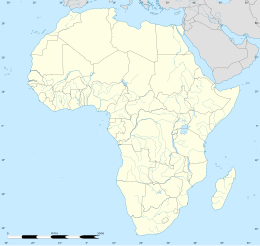Bance Island

A satellite picture of Freetown, 2006.
|
|
| Geography | |
|---|---|
| Location | Sierra Leone River |
| Coordinates | 8°34′N 13°02′W / 8.567°N 13.033°W |
| Administration | |
| Additional information | |
| Time zone | |
Bunce Island (also spelled "Bence," "Bense," or "Bance" at different periods) is an island in the Sierra Leone River. It is situated in Freetown Harbour, the estuary of the Rokel River and Port Loko Creek, about 20 miles (32 kilometres) upriver from Sierra Leone's capital city Freetown. The island measures about 1,650 feet (502.9 metres) by 350 feet (106.7 metres) and houses a castle that was built by a British slave-trading company in c.1670. Tens of thousands of Africans were shipped from here to the North American colonies of South Carolina and Georgia to be forced into slavery, and are the ancestors of many African Americans of the United States.
Although the island is small, its strategic position at the limit of navigation for ocean-going ships in Africa's largest natural harbour made it an ideal base for European slave traders. To mark the 2007–2008 bicentennial of Great Britain's and the United States' abolition of the African slave trade, a team at James Madison University created a three-dimensional animation of the castle as it was in 1805, and an exhibit on the site that traveled to museums all across the U.S. which is now held by the Sierra Leone National Museum.
Bunce Island was first settled and fortified by English slave traders in c. 1670. During its early history, the castle was operated by two London-based firms the Royal African Company and its offshoot, the Gambia Adventurers, the latter a "Crown-chartered company" or parastatal subsidised by the English government. The castle was not commercially successful but it served as a symbol of English influence in the region, where Portuguese slave traders had been established since the 1500s.
The early phase of the castle's history ended in 1728 when Bunce Island was raided by José Lopez da Moura, a Luso-African slave trader based in the area. He was the richest man in present-day territory of Sierra Leone, the grandson of a Mandé king and part of the hybrid Luso-African community that had developed along the lower rivers. This class acted as middlemen, resisting efforts by the Royal African Company to monopolise trade with African rulers. Lopez led others in destroying the Bunce Island factory.
...
Wikipedia

